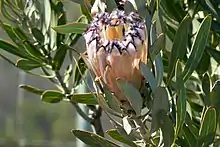| Protea laurifolia | |
|---|---|
 | |
| Cederberg, South Africa | |
| Scientific classification | |
| Kingdom: | Plantae |
| Clade: | Tracheophytes |
| Clade: | Angiosperms |
| Clade: | Eudicots |
| Order: | Proteales |
| Family: | Proteaceae |
| Genus: | Protea |
| Species: | P. laurifolia |
| Binomial name | |
| Protea laurifolia | |
| Synonyms[3][4] | |
Protea laurifolia, also known as the grey-leaf sugarbush,[3][5][6] is a shrub from South Africa.[6][7] It is native to the Cape Provinces of South Africa.[8]
Another vernacular name for this species is laurel sugarbush. In Afrikaans this species is known by the common names of louriersuikerbos, lourier-suikerbos, suikerbos and suikerkan.[3]
Protea laurifolia was first described by Carl Peter Thunberg in 1806.[2]
Description
Protea laurifolia is a tall, erect shrub which can grow up to eight metres in height.[6] The leaves are grey to bluish green and short-stalked with horny margins.[9] It flowers from mid-Autumn to early Winter, or from April to November.[5][6] The plant is monoecious with both sexes in each flower.[6]
It is similar to P. neriifolia, but has a more westerly distribution. P. neriifolia has sessile (no petiole) leaves, which curve upwards and are often somewhat more greenish.[9]
Distribution
This plant species is endemic to South Africa, but occurs in both the Northern and Western Cape provinces.[3] It is found from Nieuwoudtville to Franschhoek and Anysberg.[6] In the Western Cape it occurs in the Elands Kloof in the Hottentots Holland Mountains and the Agterwitzenberg Vlakte in the Skurweberg Mountains, part of the Koue Bokkeveld mountain range.[5]
Ecology
It grows in sandy or granite soils, at altitudes of 400 to 1,200 metres.[6] It is usually found in a fynbos habitat, but sometimes also grows on shale, or in renosterveld or scrubland.[3]
The adult plants are killed by the periodic wildfires of its habitat, but its seeds survive these events. The fruits are woody and persistent, which means they are retained on the plant after senescence.[6] The burnt skeletons of trees release the seeds from the retained dry flower heads in the season following a wildfire.[5] The seeds are dispersed by means of the wind.[6]
Horticulture
The hybrid cultivar 'Rose Mink' was selected by Dennis Perry and is sold in the US as an ornamental plant. It is fairly frost-hardy in southern Californian gardens.[7]
Conservation
The status of world population is not considered threatened.[6] It was first assessed as 'least concern' by the South African National Biodiversity Institute (SANBI) in 2009. According to the 2019 SANBI assessment the overall population is decreasing, but it was nonetheless still assessed as 'least concern'.[3]
References
- ↑ Rebelo, A.G.; Mtshali, H.; von Staden, L. (2020). "Protea laurifolia". IUCN Red List of Threatened Species. 2020: e.T113210311A185560712. doi:10.2305/IUCN.UK.2020-3.RLTS.T113210311A185560712.en. Retrieved 18 November 2021.
- 1 2 "Protea laurifolia". International Plant Names Index. The Royal Botanic Gardens, Kew, Harvard University Herbaria & Libraries and Australian National Botanic Gardens. Retrieved 20 July 2020.
- 1 2 3 4 5 6 Rebelo, A.G.; Mtshali, H.; von Staden, L. (3 June 2019). "Grey-leaf Sugarbsh". Red List of South African Plants. version 2020.1. South African National Biodiversity Institute. Retrieved 20 July 2020.
- ↑ "Protea laurifolia Thunb". Plants of the World Online. Kew Science. 2017. Retrieved 20 July 2020.
- 1 2 3 4 "Protea laurifolia (Grey-leaf sugarbush)". Biodiversity Explorer. Iziko - Museums of South Africa. Retrieved 26 July 2020.
- 1 2 3 4 5 6 7 8 9 10 "Bearded Sugarbushes - Proteas". Protea Atlas Project Website. 11 March 1998. Retrieved 20 July 2020.
- 1 2 "Protea laurifolia 'Rose Mink'". www.smgrowers.com. San Marcos Growers. Retrieved 20 July 2020.
- ↑ "Protea laurifolia". Germplasm Resources Information Network. Agricultural Research Service, United States Department of Agriculture. Retrieved 11 August 2015.
- 1 2 van Wyk, Braam; van Wyk, Piet (1997). Field Guide to trees of South Africa. Cape Town: Struik. pp. 216, 217. ISBN 1-86825-922-6.
External links
 Media related to Protea laurifolia at Wikimedia Commons
Media related to Protea laurifolia at Wikimedia Commons Data related to Protea laurifolia at Wikispecies
Data related to Protea laurifolia at Wikispecies
